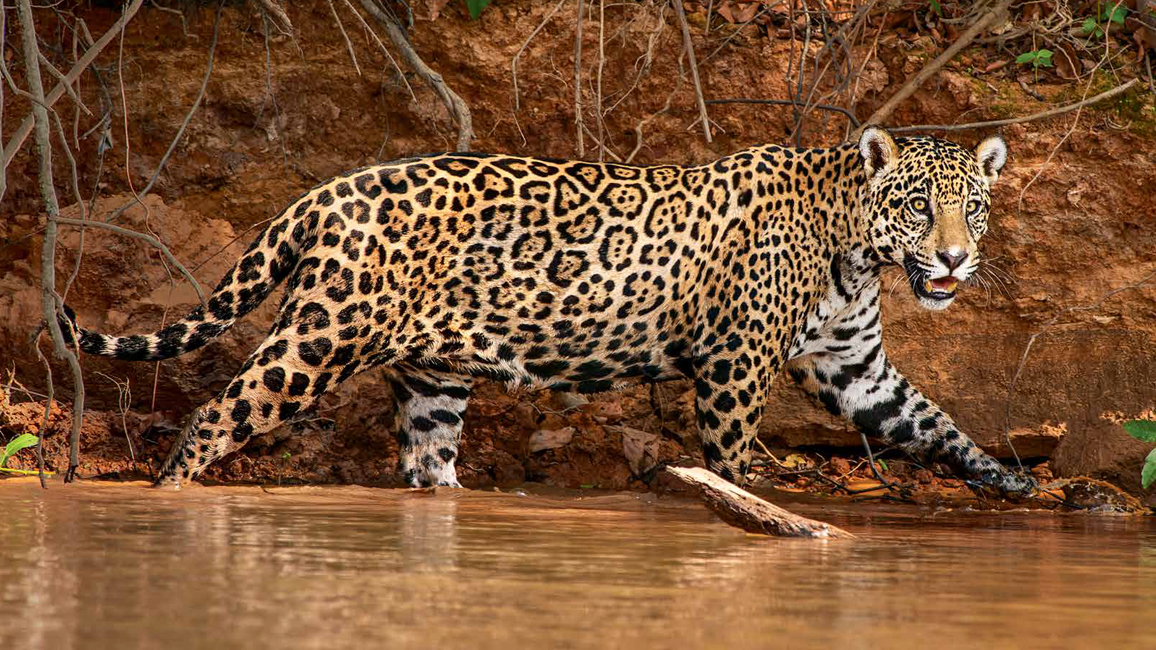
Jaguars
By Kathy KrankingUnlike most cats, a jaguar (JAG-whar) is right at home in the water.
It swims, plays, rests, and even hunts there! Jaguars spend plenty of time on land, too. But whenever they get the chance, they love to lounge in a river, stream, or swamp, just chilling out.
Jaguars live in forests, swamps, grasslands, and other places in North, Central, and South America. They’re the biggest cats in the Americas—and the third-biggest in the world. (Only lions and tigers are larger.)
The first thing you notice about a jaguar is its beautiful spotted coat. Those spots re called rosettes, because they’re shaped a little like roses. Leopards also have rosettes, but you can easily tell a jaguar from a leopard. A jaguar has smaller spots inside most of its rosettes, but a leopard usually doesn’t.
Jaguars like to be alone and stay out of sight. They will often hang out up in trees. In the dappled forest sunlight, their black-and-gold coats help the cats to blend in and “disappear.”
ON THE HUNT
Jaguars are a triple threat: They can hunt from trees, on land, or in the water. Though they can run pretty fast, they don’t depend on speed for hunting. Instead, they stalk prey until they get close, and then make a surprise attack.
While other cats kill prey with a bite to the throat, a jaguar usually bites an animal’s skull or back of the neck. Jaguars have really strong jaws— strong enough to crush the shell of a turtle, one of their favorite meals. And they aren’t picky eaters at all—they’ve been known to eat more than 80 different kinds of animals, including fish, birds, deer, anteaters, monkeys, snakes, frogs, armadillos, iguanas, tortoises, and even alligator-like reptiles called caimans (KAY-menz)!
After making a catch, a jaguar often carries its prey away to a private spot to eat it. Then it cleans itself up, just as any house cat would.
JUNIOR JAGUARS
There’s only one time jaguars like to be around other jaguars, and that’s when it’s time to mate. But after mating, a male and female go their separate ways again.
About three months later, the female gives birth in a den, usually to two cubs but sometimes to as many as four. At first, the cubs spend all their time in the den. But when they’re about six months old, they begin to follow their mom around. They even swim in the water with her.
The cubs stay with their mom until they are about two years old. Then they go off to live on their own.
TROUBLES FOR JAGUARS
Unfortunately, jaguars have their problems. In the last 100 years, more than half of their habitat has been turned into farms and ranches. For years, jaguars were killed for their beautiful coats. And ranchers often kill jaguars because they sometimes attack their cattle. Now the big cats may be in danger of becoming extinct.
But there is good news, too. Scientists have been studying ways to help jaguars. Many of the places where jaguars live are wildlife preserves. But these big cats often travel great distances outside the preserves, which means they cross roads, farms, and other areas that aren’t safe for them. Scientists thought it would be a good idea to make the pathways where the jaguars travel into protected areas, as well.
It’s a promising plan, but a hard one to get done. The pathways cross through many different countries. But so far, a lot of those countries have agreed to work together to protect jaguars. Scientists think this idea is the best way to give these beautiful cats a bright future.
“Water Cat” originally appeared in the November 2014 issue of Ranger Rick magazine.
(Click on each image above for a closer view of the story.)



















